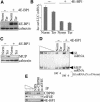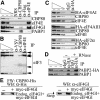The pioneer translation initiation complex is functionally distinct from but structurally overlaps with the steady-state translation initiation complex
- PMID: 15059963
- PMCID: PMC387415
- DOI: 10.1101/gad.1170204
The pioneer translation initiation complex is functionally distinct from but structurally overlaps with the steady-state translation initiation complex
Abstract
The bulk of cellular proteins derive from the translation of eukaryotic translation initiation factor (eIF)4E-bound mRNA. However, recent studies of nonsense-mediated mRNA decay (NMD) indicate that cap-binding protein (CBP)80-bound mRNA, which is a precursor to eIF4E-bound mRNA, can also be translated during a pioneer round of translation. Here, we report that the pioneer round, which can be assessed by measuring NMD, is not inhibited by 4E-BP1, which is known to inhibit steady-state translation by competing with eIF4G for binding to eIF4E. Therefore, at least in this way, the pioneer round of translation is distinct from steady-state translation. eIF4GI, poly(A)-binding protein (PABP)1, eIF3, eIF4AI, and eIF2alpha coimmunopurify with both CBP80 and eIF4E, which suggests that each factor functions in both modes of translation. Consistent with roles for PABP1 and eIF2alpha in the pioneer round of translation, PABP-interacting protein 2, which is known to destabilize PABP1 binding to poly(A) and inhibit steady-state translation, as well as inactive eIF2alpha, which is also known to inhibit steady-state translation, also inhibit NMD. Polysome profiles indicate that CBP80-bound mRNAs are translated less efficiently than their eIF4E-bound counterparts.
Figures





References
-
- Afonina E., Stauber, R., and Pavlakis, G.N. 1998. The human poly(A)-binding protein 1 shuttles between the nucleus and the cytoplasm. J. Biol. Chem. 273: 13015-13021. - PubMed
Publication types
MeSH terms
Substances
LinkOut - more resources
Full Text Sources
Other Literature Sources
Molecular Biology Databases
Miscellaneous
